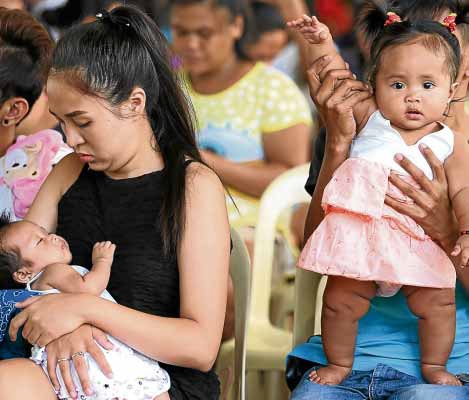There’ll be 105M Pinoys by year-end

WORLD POPULATION DAY Hundreds of couples and their babies flock to the National Government Center in Quezon City on Tuesday to celebrate World Population Day. —EDWIN BACASMAS
The population of the Philippines will hit 105.75 million at the end of the year, the Population Commission (PopCom) said on Tuesday.
Despite a declining growth rate, the country’s population continues to grow at an estimated two million people a year, said Lolito Tacardon, deputy executive director of PopCom.
“Whether this is alarming or not depends on the government’s capacity to provide services to its people,” Tacardon told reporters during the celebration of World Population Day in Quezon City.
Largest sector
“The segment of our population that remained huge is still the poorer sector,” he said.
Tacardon noted that women from poor communities were giving birth to an average of five children, compared to an average of two children for women from higher income brackets.
Article continues after this advertisementKlaus Beck, country representative of the United Nations Population Fund, said teenage pregnancy also remained an urgent concern in the Philippines.
Article continues after this advertisementData from the Philippine Statistics Authority for 2016 showed that one in 10 women of child-bearing age was a teenager. It said 24 babies are being born every hour.
One in 10 Filipino women aged 15 to 19 is already a mother or pregnant with her first child, according to the 2013
National Demographic and Health Survey.
This urgent concern may be dealt with “by coming together for age-appropriate sex education,” Beck said.
Family planning
He noted that the Philippines was in the “best opportunity in history” for vigorous action on responsible parenthood and family planning.
Despite the temporary restraining order from the Supreme Court on some provisions of the reproductive health law, Tacardon said Filipinos still had access to other family planning services at public and private health centers.
In January, President Rodrigo Duterte signed Executive Order No. 12, which intensified access to these services.
In partnership with the Quezon City government, the celebration of World Population Day featured a health caravan that provided family planning services and counseling to more than 600 couples from urban poor communities.
For 22-year-old Mae, the celebration came at a perfect time, as she expressed willingness to get a contraceptive implant after her third child.
An implant is a matchstick-size rod placed under the skin, in the inside of the arm. It releases progesterone hormones and stops the body from releasing an egg monthly.
The eldest of eight children, Mae, a resident of Payatas village, first gave birth at 18.
“Family planning is really important so I would not have to give birth again so soon,” Mae said, adding that she was following the example of her own mother, Mildred, who decided to have an implant after eight children. —With a report from Pauline Faye Tria
Fast facts
104.9 million: Philippine population in 2017 — 52.8 million males
and 52.1 million females
41 percent of population aged 25 to 29 years old, the biggest group among all age brackets
32 percent of population aged 0 to 14 years old, the second biggest group among all age brackets.
13th: rank of the Philippines in terms of population among all countries
2nd: rank of the Philippines in terms of population among Asean members, next to Indonesia’s 264 million
1.60 million: annual population increase from 2010 to 2015
125.4 million: estimated population of the country by 2030
2.88: total fertility rate by live births from 2015 to 2020, a decrease from 3.05 in 2010-2015 and 5.46 in 1975-1980.
69.3: life expectancy at birth from 2015 to 2020, an increase from 68.6 in 2010-2015 and 65.7 in 1990-1995
Compiled by Marielle Medina, Inquirer Research
Source: World Population Prospects from the United Nations Department of Economic and Social Affairs/Population Division